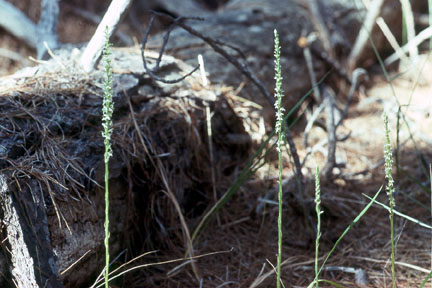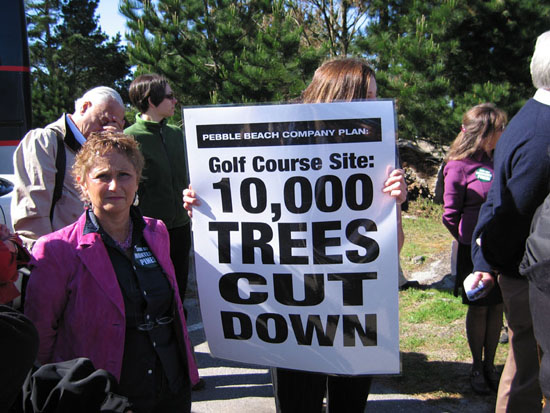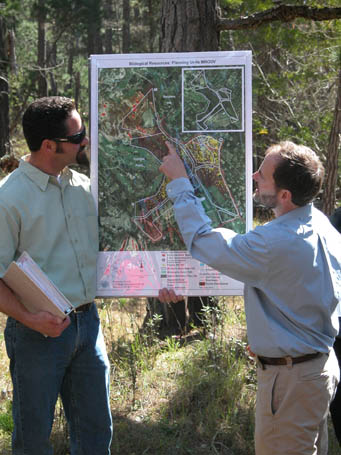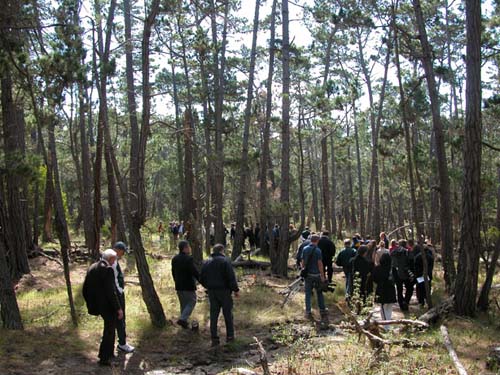 The endangered orchid, Yadon's piperia, grows where the
Pebble Beach Company wants to develop yet another golf course.
The endangered orchid, Yadon's piperia, grows where the
Pebble Beach Company wants to develop yet another golf course.
Sierra Club activists from around California joined Ventana Chapter
members at the 13-hour long Coastal Commission meeting on March
10 in Monterey. Nearly 300 people (150 of them Sierra Club members)
crowded into the conference room where the meeting was held and
listened to over 100 speakers. Members of many other environmental
groups also were present.
The day before, the Commissioners had toured the Pebble Beach property
to see for themselves just what the development plans would entail.
Club activists were on hand to point out the destruction of habitat
and threats to 19 species of special concern including the California
red-legged frog, the beautiful Monterey ceanothus and the rare,
delicate Yadon's piperia.
At the Commission meeting the next day, the Sierra Club's attorney,
Tom Lippe deftly dueled with Tony Lombardo, representing the Pebble
Beach Company. Incredibly, Lombardo described the development plan
which includes cutting down 17,000 trees as a "protection plan
for the forest."
 The blue-flowering Ceanothus
rigidus is one of the plants of special concern on the Pebble Beach
property. Photo: Linda Smith
The blue-flowering Ceanothus
rigidus is one of the plants of special concern on the Pebble Beach
property. Photo: Linda Smith
Lippe, an expert on coastal law, criticized Monterey County for
not complying with the Coastal Act and affirmed that the properties
earmarked for development are Environmentally-Sensitive Habitat
Area (ESHA) and as such, subject to protection. "It's rare
to see a project in which there is such a wide gap between the proposal
and what the law requires," he responded to Lombardo's assertion
of protection.
Many speakers from both sides addressed the Commission on various
aspects of the plan. Proponents for the project said that Measure
A was endorsed by the voters. Opponents pointed out that Measure
A was never attached to a specific plan. Many testified they felt
"duped" when they learned that Measure A and the plan
would in fact cut down over 17,000 trees and destroy one fifth of
the remaining native Monterey Pine Forest in the world.
 Sierra Club members protest
the Pebble Beach Company’s plan to cut down a total of 17,000 trees for
the 21st golf course in Monterey County. Photo: James McGrew
Sierra Club members protest
the Pebble Beach Company’s plan to cut down a total of 17,000 trees for
the 21st golf course in Monterey County. Photo: James McGrew
Four is enough
In 1985, when the Coastal Commission approved the Spanish Bay golf
course and resort at Pebble Beach on a 6-5 vote, the Pebble Beach
Company assured the Commission that four golf courses would be all
that the Company would ever need or ask for.
In 1990, the Pebble Beach Company, then owned by Sumitomo Bank
of Japan, abandoned those assurances, proposing a fifth golf course.
Since actor-turned-real-estate-developer Clint Eastwood and a consortium
of golf and business notables purchased the Pebble Beach Company
in the late 1990's, they have continued to lobby furiously for approval
of this fifth golf course.
 Commission Tour Map
Commission Tour Map
The 1985 approval of the Spanish Bay project had numerous binding
conditions including conservation easements on the Sawmill Gulch
site. The current plan calls for removal of those conservation easements
to build a high intensity equestrian recreation site that would
severely impact the adjacent fragile Huckleberry Hill Preserve.
There was also to be restoration of sand dunes and forested areas
and the existing Haul Road was to be closed. These promises were
never kept.
The Coastal Act, of course, prohibits the wholesale destruction
of environmentally-sensitive coastal habitat and resources for golf.
The Coastal Act requires balance, and implicitly recognizes that
humans cannot live on golf alone. Native Monterey pine forests,
on the other hand, are a rare and increasingly threatened ecosystem.
 Commission Touring
Commission Touring
How to help
o If you have not already done so, please write the California Coastal
Commission and ask that they protect the genetically-diverse native
Monterey pine forest ecosystem for future generations. Golf can
be played anywhere; once the native Monterey pine forests and the
plants and animals they shelter are gone, they are gone forever.
Mail your letters to California Coastal Commission, 725 Front Street,
Suite 300, Santa Cruz, CA 95060-4508.
o Consider attending the Coastal Commission meeting in June in Santa
Rosa where the final decision on this issue will likely be made.
For more information contact Coastal Chair D'Anne Albers, 375-1389.
|

